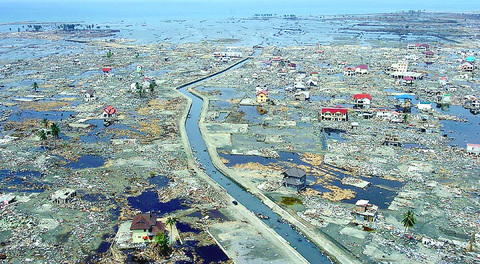Taiwan has not been invited to a summit of major donors to the relief operation in the wake of the tsunami which devastated countries around the Indian Ocean on Dec. 26.
This is in spite of Taiwan's being one of top 10 donors of aid, having pledged US$50 million to the relief effort.

PHOTO: AFP
While the Ministry of Foreign Affairs told the Indonesian government which is hosting the summit that it would like to attend, Jakarta didn't even bother to reply.
Ministry spokesman Michel Lu (呂慶龍) declined to comment on whether Indonesia, which received considerable aid from Taiwan since the disaster, has treated Taiwan unfairly by barring it from the conference.
"We simply want to express our strong hope that we can attend the meeting," he said.
Taiwan has concentrated its relief efforts on Thailand and Indonesia and Minister of Foreign Affairs Mark Chen (陳唐山) called on the international community to allow Taiwan to join the Jakarta conference, at least in the capacity of an observer.
Meanwhile destruction on Indonesia's tsunami-wracked Sumatra island is the worst US Secretary of State Colin Powell has ever seen, the battle-seasoned war veteran said as he prepared for a meeting of world leaders to coordinate history's largest relief operation.
"I can not begin to imagine the horror that went through the families and all of the people who heard this noise and then had their lives snuffed out by this wave," Powell said yesterday after flying over flattened villages along Sumatra's northern coast, which was home to two-thirds of the nearly 150,000 killed across Asia.
"I've been in war and I've been through a number of hurricanes, tornados and other relief operations, but I've never seen anything like this."
So far US$2 billion has been pledged to relief efforts in 11 countries hit by the Dec. 26 quake off the western coast of Indonesia that triggered waves causing deaths as far away as East Africa.
But the challenges are enormous, with millions homeless and threatened by disease. The UN said it will build camps on Sumatra for up to 500,000 people.
Haggard, dehydrated tsunami survivors have been flooding hospitals. Psychologists were struggling to help children cope with the unspeakable tragedy. Aftershocks added to the threats, with another strong quake felt yesterday, rattling the region but causing no known injuries.
Powell was one of the first to arrive in Indonesia ahead of today's donor's conference, where world leaders will iron out problems coordinating the relief operation and discuss the need for a tsunami warning system for the Indian Ocean. One already exists in the Pacific.
From an altitude of a few hundred meters, Powell and his entourage saw not a tree or building standing along the coast. City block after city block in Banda Aceh, the main city on northern Sumatra, had been swept clean. A large ship lay on its side, half submerged in water and mud.
The former US army general said he saw "how the wave came ashore, pushing everything in its path -- cars, ships, freighters overturned -- all the way up to the foothills, and then starting up the foothills until finally the waves came to a stop."
Money has poured in from around the world, the largest share from Japan.
"I think Japan must do as much as it can to help," Prime Minister Junichiro Koizumi said, calling for companies in the world's second-largest economy to respond with donations to the kind of disaster seen "only once a century."
But the fragility of relief and rehabilitation efforts was underscored by the temporary closure Tuesday of the main, overstretched airport in Sumatra. Yesterday, a load of aid supplies fell from a US helicopter over the island's city of Medan, hitting a shopping mall. No one was hurt.
Pilots, meanwhile, were ferrying survivors from hard-hit towns and villages in the region to medical help. But that created a new challenge for relief workers: bottlenecks at overcrowded hospitals.
About a dozen people lay on stretchers on the sidewalk outside Fakina Hospital in Banda Aceh. Many of the hospital's rooms had no power. Walls were flecked with blood and doctors had run out of stands for intravenous fluid bags, hanging them from cords strung across the ceiling.
"It's heartbreaking," said Leslie Ansag of Everett, Washington, a Navy medic from the American aircraft carrier USS Abraham Lincoln, which was off Sumatra to help the rescue effort.
In Thailand, where more than 2,200 foreign tourists were among 5,000 killed, police said they were searching for a 12-year-old Swedish boy last seen leaving a hospital with an unknown man the day after the tsunami hit.
Also see stories:
Realtor donates NT16.9 million for disaster relief
Self-styled doctors pose health risk to survivors

The Ministry of Foreign Affairs (MOFA) yesterday said it is closely monitoring developments in Venezuela, and would continue to cooperate with democratic allies and work together for regional and global security, stability, and prosperity. The remarks came after the US on Saturday launched a series of airstrikes in Venezuela and kidnapped Venezuelan President Nicolas Maduro, who was later flown to New York along with his wife. The pair face US charges related to drug trafficking and alleged cooperation with gangs designated as terrorist organizations. Maduro has denied the allegations. The ministry said that it is closely monitoring the political and economic situation

UNRELENTING: China attempted cyberattacks on Taiwan’s critical infrastructure 2.63 million times per day last year, up from 1.23 million in 2023, the NSB said China’s cyberarmy has long engaged in cyberattacks against Taiwan’s critical infrastructure, employing diverse and evolving tactics, the National Security Bureau (NSB) said yesterday, adding that cyberattacks on critical energy infrastructure last year increased 10-fold compared with the previous year. The NSB yesterday released a report titled Analysis on China’s Cyber Threats to Taiwan’s Critical Infrastructure in 2025, outlining the number of cyberattacks, major tactics and hacker groups. Taiwan’s national intelligence community identified a large number of cybersecurity incidents last year, the bureau said in a statement. China’s cyberarmy last year launched an average of 2.63 million intrusion attempts per day targeting Taiwan’s critical

‘SLICING METHOD’: In the event of a blockade, the China Coast Guard would intercept Taiwanese ships while its navy would seek to deter foreign intervention China’s military drills around Taiwan this week signaled potential strategies to cut the nation off from energy supplies and foreign military assistance, a US think tank report said. The Chinese People’s Liberation Army (PLA) conducted what it called “Justice Mission 2025” exercises from Monday to Tuesday in five maritime zones and airspace around Taiwan, calling them a warning to “Taiwanese independence” forces. In a report released on Wednesday, the Institute for the Study of War said the exercises effectively simulated blocking shipping routes to major port cities, including Kaohsiung, Keelung and Hualien. Taiwan would be highly vulnerable under such a blockade, because it

UNDER WAY: The contract for advanced sensor systems would be fulfilled in Florida, and is expected to be completed by June 2031, the Pentagon said Lockheed Martin has been given a contract involving foreign military sales to Taiwan to meet what Washington calls “an urgent operational need” of Taiwan’s air force, the Pentagon said on Wednesday. The contract has a ceiling value of US$328.5 million, with US$157.3 million in foreign military sales funds obligated at the time of award, the Pentagon said in a statement. “This contract provides for the procurement and delivery of 55 Infrared Search and Track Legion Enhanced Sensor Pods, processors, pod containers and processor containers required to meet the urgent operational need of the Taiwan air force,” it said. The contract’s work would be